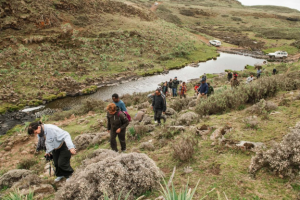
Yihew Biru is a Wild Animal Researcher. He has been teaching and researching enthusiastically about wild animals for more than ten years. He aspires to see Ethiopia’s wildlife resource effective rehabilitation. He is contributing his part to the conservation activities based on scientific researches.
He underlined the need for genuine participation of all stakeholders’ to wildlife conservation in the country. Giving more attention to the issue is important to keep life sustaining smoothly without causing any harm to nature. Currently, he is engaged in conducting various researches specifically on wild animals at the Gullele Botanical Garden.
Yihew Biru told The Ethiopian Herald that researching wildlife and its ecosystem gives him pleasure and he feels superior while watching nature is conserved. He said Ethiopia is blessed with diversified endemic wild animals and bird species as well as indigenous plants. Thus, the country could easily attract numerous international and local tourists through effectively developing the sector.
Gullele Botanical Garden is solely established to conserve the country’s vast biodiversity resources and conduct successive research in the area. In addition, it provides effective eco-tourism services at the outskirts of Addis Ababa. For the past couple of years, Gullele Botanical Garden was dominantly covered by Eucalyptus trees.
However, following the establishment of the Gullele Botanical Garden in collaboration with Addis Ababa City Administration and Addis Ababa University numerous indigenous plants have been replaced by Eucalyptus tree. Thus, the indigenous trees proved that it contributes a lot to maintain the ecosystem and restore rivers inside the garden and its environs.
Moreover, indigenous plants have an indispensable role to create conducive habitat for the wild animals. The indigenous plants are highly preferable by the wild animals for feeding and sheltering. The quantity and variety of the wild animals inhabited at the Gullele Botanical Garden is increasing from time to time following the suitable ecosystem, he noted.
“Unlike other national parks in the country, Gullele Botanical Garden is free from human-wildlife conflict. Most of the country’s national parks are exposed to human intervention especially when farmers try to practice illegal hunting and grazing. Here, only visitors and employees of the park have access to the park. There is also a place where tourists will not enter so as to guarantee the peace of the animals,” he said.
Currently, he is conducting research on the wild animals that are found inside the park. Identifying the variety and quantity as well as the human-wildlife conflict at the park is the core priority of his research. Based on the research it is possible to improve the situation of the wild animals and the plant species at the Gullele Botanical Garden, he added.
As to him, the vertebrate species are highly utilized for research, education, and eco-tourism. Currently, more than 16 species of mammals are found inhabited in the park. Of these, 12 are grouped under the medium and large mammals. Menelik Bushbuck is among the endemic wild animals found inside the Gullele Botanical Garden. Menelik Bushbuck is only found in Ethiopia, specifically, at the Bale and Arsi mountains. Gullele Botanical Garden is found at the same position with Bale and Arsi mountains above sea level. Thus, it becomes a favorable place for wild animal conservation brought from different national parks.
Leopard, Menelik Bushbuck, hyena, fox, Bush Duiker, app, rabbit, hog, among others medium and large mammal species are found inside Gullele Botanical Garden and are easily accessible for tourists. More importantly, Gullele Botanical Garden has become a suitable conservation area for flora and fauna as it entertains a similar climate condition with most of the country’s wild animal’s inhabitations.
According to him, Gullele Botanical Garden also works in collaboration with other local and international stakeholders regarding plant species and wild animal conservation. The Ethio-Russia Biological Expedition Group that embraces numerous wildlife researchers is among the leading collaborators of the park.
These Russian scientists are undertaking various researches focusing on small mammals such as rats, dormouse, and woodchuck, among others found in Gullele Botanical Garden. Based on this collaborative research, the park recorded 6 rat species. From this, the 4 rat species are identified as endemic animals that are only found in Ethiopia.
Regarding bird species, Ethiopia inhabits 926 bird species out of 11,000 bird species that are found worldwide. More than 100 bird species have been recorded in the Gullele Botanical Garden. Out of 926 bird species found in Ethiopia 19 are endemic. From 100 bird species that are found in the Gullele Botanical Garden 2 are endemic namely the Abyssinian Cat Bird and the Yellow Fronted Parrot. The other 11 bird species found in the park are endemic but shared only with neighboring Eritrea and Somalia.
Therefore, Gullele Botanical Garden has a meaningful role in conserving the diversified mammals, birds and plant species. The availability of indigenous plant species inside the park enables the wild animals and birds to access their preferable feed. Similarly, other amphibian, insect, and reptile species are also found in the park, he said.
The replacement of eucalyptus trees and the plantation of numerous indigenous plant species at the park also contribute to promoting biodiversity. Tid, Zigba, Kosso, Olive, among others are the leading indigenous plant species that are found in the Gullele Botanical Garden. Deforestation, swift population growth, climate change, industrialization, environmental pollution and emergence of new weeds are among others putting pressure on wild animals worldwide.
On the other hand, the improving public awareness towards wildlife, establishment of new national parks and sanctuaries, and community based conservation activities help to maintain the country’s wildlife resources effectively. Accordingly, Gullele Botanical Garden gathers, domesticates, duplicates, conserves, and undertakes research on both flora and fauna. Currently, Gullele Botanical Garden maintains more than 1,200 plant species.
BY TEWODROS KASSA
THE ETHIOPIAN HERALD FRIDAY 28 JULY 2023





